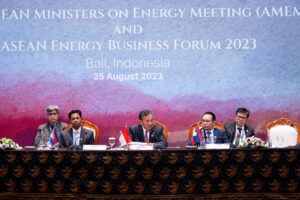Menu

Photo 1. ASEAN Ministers on Energy, HAPUA, ASCOPE, and ASEAN Secretariat
The ASEAN Centre for Energy (ACE) participated in the 41st ASEAN Ministers on Energy Meeting (AMEM-41) and its Associated Meetings, that was held in parallel with the ASEAN Energy Business Forum (AEBF) 2023 on 24-25 August 2023 in Bali, Indonesia. The two-day meetings, chaired by H.E. Arifin Tasrif, Minister of Energy and Mineral Resources of the Republic of Indonesia, brought together Ministers on Energy from ASEAN Member States (AMS), Dialogue Partners, and International Organisations. The Meeting also welcomed Timor-Leste as an observer.

Photo 2. H.E. Arifin Tasrif, Minister of Energy and Mineral Resources of the Republic of Indonesia at the opening ceremony of AMEM-41 & AEBF 2023.
APAEC Phase II: Mid-Term Review and Pioneering Energy Interconnectivity Initiatives
One of the key highlights of AMEM-41, Dr Nuki Agya Utama, Executive Director of ACE, elaborated on the mid-term review of the ASEAN Plan of Action on Energy Cooperation (APAEC) Phase II, which assessed challenges and identified opportunities for improvement in its implementation towards achieving regional energy goals by 2025.
He highlighted the remarkable incremental progress the APAEC Phase II implementation, including the completion of 9 out of 18 interconnection projects, effectively linking eight (8) ASEAN countries towards the realisation of the ASEAN Power Grid. Additionally, the ASEAN Interconnection Masterplan Study III (AIMS III) Phase 1 and Phase 2 Updates by ACE has been completed, which provided detailed analysis and strategy for higher capacity additions for the future prioritised interconnections.

Photo 3. ACE’s MoU Signing Ceremony, witnessed by ASEAN Ministers
At the sidelines of the AMEM-41, ACE solidified its commitment to advancing region’s sustainable energy security and connectivity through several Memoranda of Understanding (MoUs) with key partners:

Photo 4. Dr Nuki Agya Utama at AMEM-41
ASEAN Energy Outlook and Navigating Energy Needs Amid Economic Growth Post-2025
ACE briefed the Ministers on the region’s energy outlook from expected economic growth in the region and its implications for energy requirements. The Centre emphasised the need for energy cooperation and innovation to accelerate the energy transition.
Dr Nuki said, “Energy transition can be accelerated through energy cooperation and innovation. That is what we believe and push through within ASEAN. Among others, it has been shown that the realisation of ASEAN’s cross-border interconnection under the ASEAN Power Grid is a cost-optimised solution, and can lead to higher penetration of renewable energy, including those of solar and wind. Following the success of Lao PDR, Thailand, Malaysia, and Singapore Power Integration Project (LTMS PIP), the region is planning the extension of the project, including the addition of Cambodia, also expansion to another sub-region such as Brunei Darussalam, Indonesia, Malaysia, and the Philippines (BIMP) PIP.
Additionally, recognising that financing can be both an obstacle and a catalyst for energy transition, Dr Nuki highlighted the substantial investments required for the transition away from fossil fuels. In the power sector, according to the 7th ASEAN Energy Outlook (AEO7), the investment needs range from 726-1,070 billion USD from 2021-2050. It is imperative that the region addresses this financial aspect to ensure the success of its sustainable energy endeavours.
Dr Nuki also laid out the directions towards the development of the next-cycle of APAEC, which will integrate cross-sectoral partnerships in strengthening energy security and resiliency towards just and sustainable energy transition. The 8th ASEAN Energy Outlook will be its cornerstone in keeping abreast with key global and regional trends post-2025.

Photo 5. AMEM-41 Press Conference with ASEAN Ministers from Cambodia, Indonesia, and Lao PDR, accompanied by SOE (Senior Officials on Energy) Leader of the Republic of Indonesia and Executive Director of ASEAN Centre for Energy
Adoption of the Joint Declaration on Sustainable Energy Security through Interconnectivity
Minister Arifin Tasrif announced the adoption of the Joint Declaration on Sustainable Energy Security through Interconnectivity, a significant milestone that underlines the region’s focus on energy interconnectivity, including the ASEAN Power Grid (APG) and Trans-ASEAN Gas Pipeline (TAGP), to be achieved by 2045.
Minister Arifin stated in his remarks, “In this ASEAN Chairmanship year, we address the theme of ASEAN matters: Epicentrum of growth and it represents our challenges as one of the most growing and promising areas of the global economy. As economies grow, energy demand increases. ASEAN region, with its enormous resources on green and renewable energy, should put in its best effort in implementing a transition to achieve net zero emissions.”
He also emphasised, “Therefore, for the ASEAN Chairmanship 2023, Indonesia addresses a key deliverable on sustainable energy security through interconnectivity. The ASEAN Power Grid and Trans-ASEAN Gas Pipeline projects will elevate the utilisation of green and renewable energy sources across ASEAN member states as backbone of sustainable energy systems in the region.”
The Ministers extended his heartfelt appreciation to Indonesia’s ASEAN Chairmanship, the ASEAN Secretariat, and the ASEAN Centre for Energy for their leadership in advancing ASEAN energy cooperation.
Related Links:
